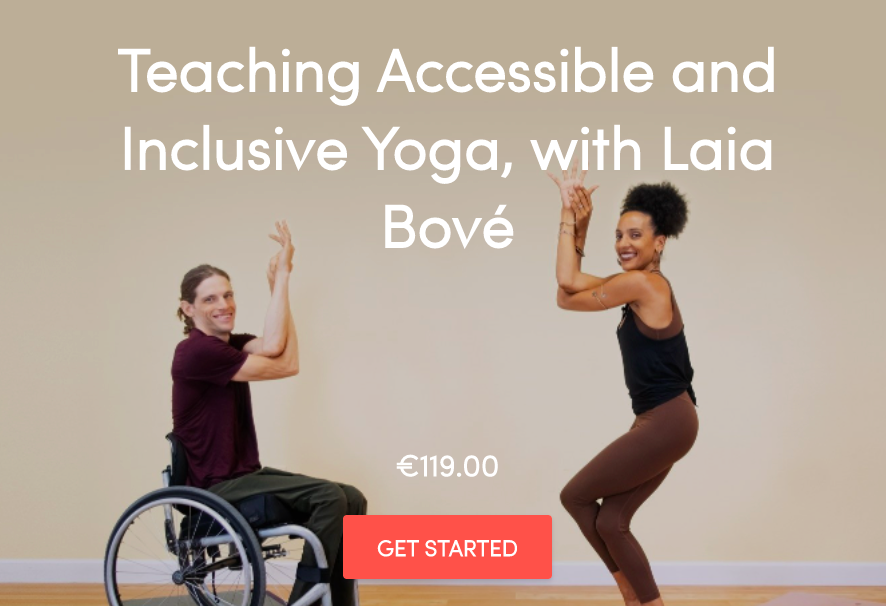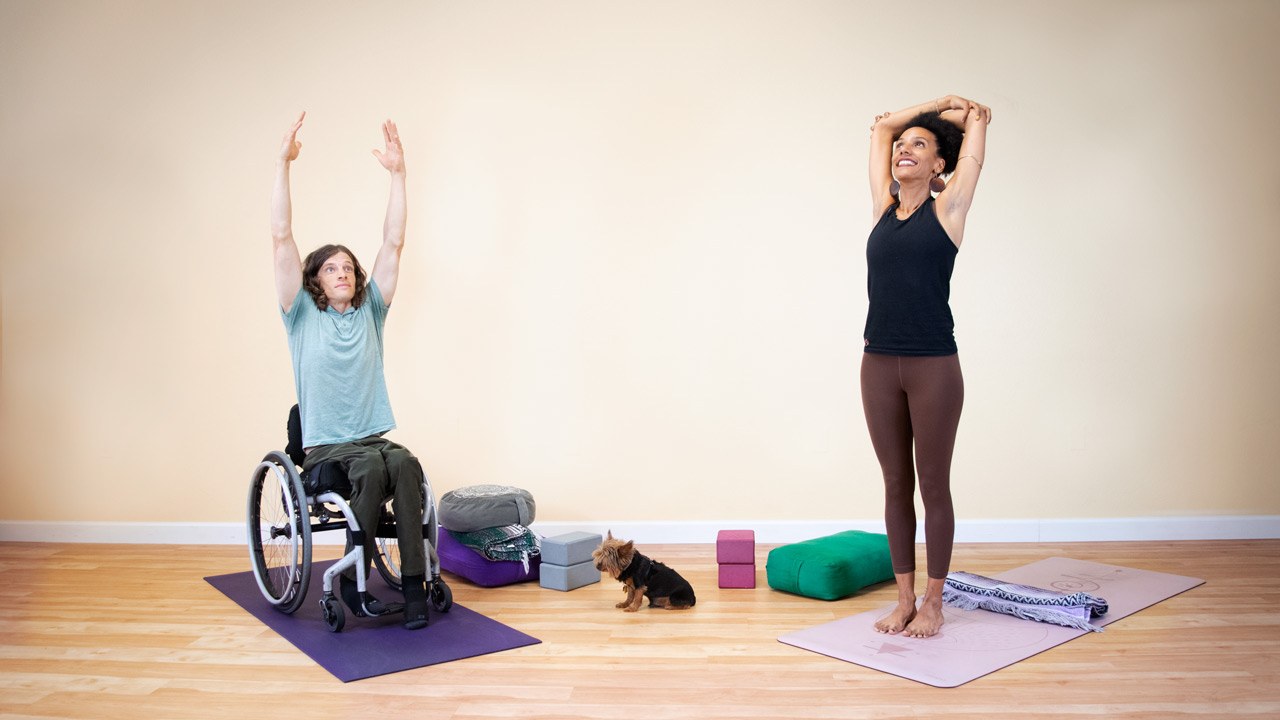Just like everything else in life, yoga has evolved. The world has shifted pace and our priorities and needs have changed as a result. It is inevitable that our yoga practice too must adapt to meet these needs. As practitioners and teachers of yoga we must take a moment to pause – to reevaluate what accessibility and inclusivity mean to us, and how that impacts the way in which we show up as students and guides.
Defining accessibility and inclusivity
In the last few years, and to the joy of many, the words ‘accessibility’ and ‘inclusivity’ have begun to gain relevance in the yoga world. If we look at the dictionary, these are their definitions:
Accessible:1a: capable of being reached
1b: easy to speak to or deal with
2: capable of being used or seen: AVAILABLE
3: capable of being understood or appreciated
4: capable of being influenced: OPEN
5: easily used or accessed by people with disabilities: adapted for use by people with disabilities
Inclusive:1a: broad in orientation or scope
1b: covering or intended to cover all items, costs, or services
2: including everyone especially: allowing and accommodating people who have historically been excluded (because of their race, gender, sexuality, or ability)
3: of or relating to education in which students with disabilities are included with the general student population
4: including the stated limits or extremes – used postpositively
Diving deeper
While it’s useful to define accessibility and inclusivity, there is so much more to consider when we talk about what accessible and inclusive yoga can look like…
Even now, the population that attends yoga classes, workshops, retreats, and events – as well as the majority of teachers – is fairly homogenous. It’s a direct reflection of the lack of access and inclusivity in the yoga industry.
Even now, the population that attends yoga classes, workshops, retreats, and events – as well as the majority of teachers – is fairly homogenous. This is a direct reflection of the lack of access and inclusivity in the yoga industry.
As a yoga teacher or studio owner you may wonder why a wider range of people don’t come to your classes, despite labelling all your classes ‘for all’ or adding a teacher of colour to the schedule. Here’s a brief overview of some things you may want to consider so you can start to walk the talk, and truly invite more BIPOC, disabled folks, and more diversity in general into your classes and yoga spaces.
For a more in-depth look at teaching accessible and inclusive yoga, please check out my teacher training course on the EkhartYoga Academy.
1. Inclusive language and cueing
One of the first things we can do when we begin to consider inclusivity is pay greater attention the language we use when we interact with our students. This includes before and after class. It includes the words that we choose to support and guide students’ practice, how we cue transitions, and how we hold space. Be mindful of what you say and how you say it so you can support as many of your students as possible.
2. Trauma-informed and Resilience-focused yoga
It’s not our role as yoga teachers to diagnose or attempt to treat a student’s physical or mental condition or ailment. However, it is useful to learn more about trauma. This is something that affects each and every one of us, and from where a lot of our ‘issues’ originate.
Much of the time, people come to yoga with the goal to fix or improve something in themselves that is no longer working for them. They often show up ‘raw’, searching for a community to support them and allow them to heal and grow. Trauma-informed care can enable us to better support students, help them to connect with themselves and build resilience as they move through their challenges
If you’re not trauma-trained, it’s worth expanding your education in this field. There are many wonderful and comprehensive trainings that can provide you with tools that will benefit your community and students. Please see the reference list at the bottom of the article for further information.
3. Yogic philosophy and accessibility
Thinking – or experiencing – that the physical practice of yoga is simply not accessible is one of the most common reasons people give for not doing it. “I can’t touch my toes, I can’t practice yoga”, they may say. And though that may be true, they can certainly practice yoga. Especially when we consider that touching our toes – or doing any sort of shape – is only one layer of a multi-faceted practice.
If people aren’t able to enjoy yoga because they’re physically unable to do certain shape, we may need to pause and consider if we have some ableism to deconstruct in the way we teach. Exploring beyond asana practice and diving into philosophy and other aspects that tap into our energetic body can make the the practice accessible to more people. Moreover, it creates the space to move away from the belief that yoga is purely about postures and movement. Adding pranayama, meditation, chakra work – even meaningful conversation – can be transformative, and is as ‘yogic’ as getting into Downward Facing Dog.
4. Adapting asana
When it comes to asana, there are many different styles and yogic practices that may be more – or less – accessible. Hatha, Restorative, Chair yoga, Iyengar, even Vinyasa yoga are fairly easily modified. More regimented practices (e.g. Ashtanga) may be more challenging to adapt, but there are plenty of teachers who have found a way.
Bringing props like blocks, blankets, straps, and bolsters into any class you teach can quickly add a layer of accessibility. Remembering to demonstrate with props and offer variations and modifications is paramount to making the practice more accessible students gain more autonomy and power of choice in their practice, they often begin to take this off the mat. This when transformation begins…!
5. Accessible and inclusive offerings
Access doesn’t only refer to physical access, but financial as well. Many yoga studios offer membership prices that are prohibitive to a large group of folks. Again, a contributing factor the lack of diversity and inclusivity in wellness and yoga spaces. If you’re serious about being accessible, perhaps start by researching ways in which you can offer scholarships or pricing options.
6. Accessible and inclusive spaces
Virtual and physical spaces both come with their advantages and challenges – again, what does your community need? For example, if you teach a group of adaptive athletes who use wheelchairs in a physical space, check for any physical barriers like steps, width of doorframes, etc., before you invite your group there.
7. Serve your community
As ‘inclusive’ as it may seem to say that our classes are for all, ALL is a tall order. As teachers, leaders and students of yoga, we can, instead, shift the focus to our specific communities; the people we want to serve on a daily basis.
We must also shift away from performative practices where asana gets the spotlight and the other layers of yoga are ignored. We must create space and access to the practice of yoga in a way that genuinely supports our students’ intentions and journeys.
Little by little, one breath at a time, we can learn to create holistic, accessible, and inclusive yoga experiences.
References and further study
Trauma Informed Care – Implementation & Resource Center
ADA – Americans with Disabilities Act
Further Training:
Trauma Informed Yoga Teacher Training (200h Training) – Claire Santos
Further reading:
- The Deepest Well – Nadine Burke Harris, MD
- Accessible Yoga – Jivana Heyman
- Yoga for all Everyone – Dianne Bondy
- The Body Keeps the Score – Bessel van der Kolk
Train with Laia on the EkhartYoga Academy!

Teaching Accessible and Inclusive Yoga
This 5-hour course is specifically designed for yoga teachers who are ready to bring accessibility and inclusivity into their offerings and into the spaces in which they teach.
It’s packed full of resources to enable you to adapt and make your classes, sequences, and language, cues, and teaching spaces accessible for those with different abilities, needs, ages and backgrounds. Find out more…

